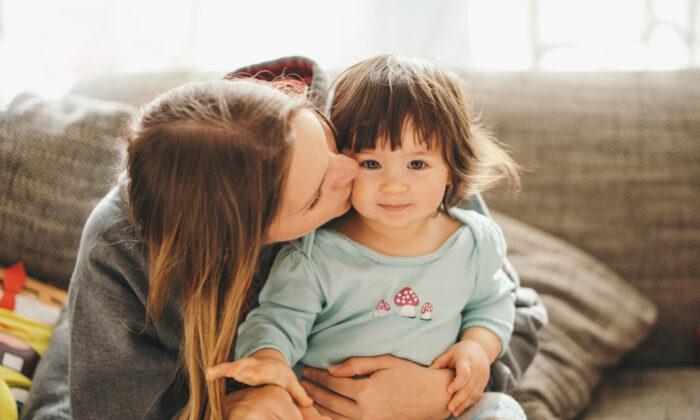The worldwide spread of COVID-19 is both scary and concerning. It has brought us all a lot of uncertainty, but as many of us are now staying at home, we have unexpected and precious time with our families.
If your children are young, I hope you are cherishing this closeness with them. However, increased closeness almost always brings new tensions into play, and if you’re not used to hanging out all day with toddlers, you may be feeling like you’re about to unravel. If so, please read further.
I’m a stay-at-home mom of two and I’ve unraveled my share of times, but from these painful experiences I’ve learned two things: All uncomfortable dynamics with toddlers are fixable, and that, as the parent, I have full control to fix it—if I’m willing to find my shortcomings and put in the effort to fix them.
Now you may be thinking that since only one of your children is causing the issues, it must be that child and not you, because the rest are fine. Please don’t compare your children with each other or with other kids. If you are blessed with difficult children (and some children seem to come that way) then you are truly blessed because they will help you get to the depths of your heart and soul, and the love and wisdom you will gain from parenting them well will be immense.
The second thing to consider is that if your children are acting out, they are probably reacting to the environment you have created for them. Elements in the environment to consider include diet, the cleanliness of the home, the number of toys, and your parenting style and moods.
If you’re in need of some motivation I recommend watching some episodes of British supernanny Jo Frost and/or dog trainer Cesar Milan. The common theme running through both of these is that children and dogs with very strange behaviors or consistently aggressive or obsessive behaviors change dramatically when their parents/owners step up their game.
Boundaries
After babies are born, we quickly become accustomed to meeting their every need right away. However, when they become toddlers, we start needing to discern their wants from their needs, which is not always easy! So it may be only after they age that we see with clear hindsight, and learn what certain behaviors we should have nipped in the bud.With boundaries, my general rule of thumb is don’t let your children do things you don’t like them to do. However, as you well know, it does not work just to tell a young child to stop or change their behavior. You will have to teach them—model the behavior you want to see and have clear consequences if they don’t. You will also need to consider if your behavior is unknowingly encouraging theirs.
For example: your child won’t sit through a meal. You might need to first consider the quality of the meal environment. Are you sitting with them or are you bustling around? If they see you moving, they probably see no reason to stay put. I try to eat with my kids as often as possible. We say a little blessing before the meal, which many young children really seem to love, and then we talk about things or read stories (after every page they eat a bite), or I bring a small toy to the table for a little puppet show. This of course takes some patience and dedication on my part, but I’ve been rewarded with kids who look forward to mealtimes and eat well.
It will take some careful consideration on your part to understand how to set correct boundaries in problem areas. An excellent and concise book for setting good boundaries is: “Love and Logic Magic for Early Childhood.”
Some key principles for good boundaries from the book are:
“Replace anger and frustration with empathy.” “Replace threats and warnings with simple actions.” “Set limits you can enforce.” “Give away control you don’t need.”
An example of simple actions from the book: baby spits out food that he normally likes. You determine that the food is not spoiled, and he is testing the limits. You say with “gentle, sweet sorrow” something like: “How sad. Lunch is over.” Then calmly put him in his crib and clean up.
Warmth
Warmth is the real key to enjoyable and productive interactions with young children. In fact without it, no technique will produce a happy cooperative child.It’s a similar principle to good customer service—when the agent takes your problems seriously and tries to be helpful, you want to do business with the company again. If the agent is curt, you will probably go elsewhere. Children can’t choose to take their business anywhere else, but they will reflect our grumpiness right back at us, often in unexpected and maddening ways.
“Take her clothes off!” my 4-year-old screamed today, referring to the apparel I’d just put on his younger sister. I had spent too long on a video call with my family and had ignored the early warning signs that he was reaching his limit. He certainly didn’t care what she had on; he was upset because I was paying attention to her while he needed TLC.
Warmth is what fosters a deep connection with a child and is very healing and fortifying—something we all can use right now. It can be expressed quietly with eye contact, a smile, or with enthusiastic praise; it comes from a place of calm and optimism. When you increase your warmth toward young children it builds a wonderful buffer for the inevitable conflicts.
Of course you will not always be able to find warmth during a conflict, but if you make the effort to practice warmth when times are easy, it will increase your capacity during the tough times.
And there is nothing quite like seeing the joyful sparkle in a child’s eye when they feel appreciated and loved.
I have had great success gaining cooperation too by increasing my efforts to connect in a loving way with my children during the day.
Some ideas for increasing warmth: beginning the day with cuddles, some massage, a good story, or even some rough-and-tumble games on the bed (if you’re up for it) get things off on a positive note; singing together (as long as you enjoy it); taking care as you dress them; noticing and commenting on their interests during the day; and offering sincere praise for their good behavior and accomplishments.
In order for you, the adult, to maintain warmth, it’s of course important to be kind and gracious with yourself as well as disciplined. These are tough times and you may be under a great deal of stress for many reasons, including finding yourself squeezed between full-time childcare and working from home.
If this is the case, I suggest waking early to work and working when they sleep. Young children have little tolerance for watching us stare at a screen.
Now maybe mornings and evenings are usually your “me time”? As many of us stay-at-home mothers have found, you probably need to recalibrate self-care. Right now, you may not be able to take time in the evening to relax and entertain yourself because you have to work. But I encourage you to find great relaxation and calm during the day. This is much easier if you have a solid routine and you can find small ways to increase your moments of enjoyment. For example, allow yourself 15 minutes of reading with a hot beverage. Listen to your favorite show as you clean up at night. I like to meditate next to my kids as they fall asleep, as I find it relaxes and refreshes me for the night’s work ahead.
A good book to further explore warmth is “Joyful Toddlers and Preschoolers: Create a Life That You and Your Child Both Love.”
Good luck! I wish you great enjoyment and parenting success in the time ahead.







Friends Read Free